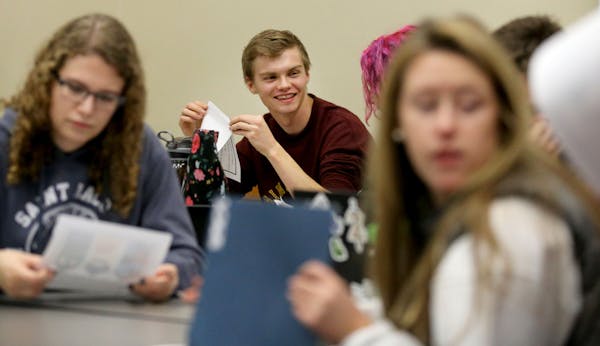The Minnesota State Colleges and Universities system is gearing up to make an ambitious funding request to state lawmakers in exchange for a pledge to freeze undergraduate tuition.
The system is planning to seek $246 million more in state dollars over two years, or a hike of more than 17 percent for the biennium. The money would fund employee pay increases and other operational costs at the system's seven universities and 30 colleges as well as a new information management system, new scholarship programs and a push to address workforce shortages. If the Legislature grants the full request, Minnesota State leaders vow to keep undergraduate tuition flat.
Over at the University of Minnesota, officials note that's an approach the U tried last year — and did not succeed. This coming session, a chastened U is getting ready to make a more modest request, which would increase its biennial appropriation by less than 7 percent. But officials at Minnesota State, which fared better than the U during the 2017 session, say faculty and students pressed them to think bigger this time.
"We've been urged to ask for what we need and include our aspirations," Laura King, the system's vice chancellor and chief financial officer, told its governing board. She said one reason the request is large is "because we're seeking to avoid a tuition increase."
Minnesota State trustees reviewed their administration's budget proposal at Winona State University this week; they will vote on it in November. If the request is granted, the system would receive more than $870 million a year in state funding by 2021.
Promising a freeze
Officials said the bulk of the Minnesota State ask, or about $169 million, will go toward keeping up with inflation, including $111 million for salary and benefit increases.
Minnesota State is seeking another $37 million to help replace an outdated information management system. Officials say the new system would be key for running its campuses smoothly and efficiently, tracking information related to admissions, course schedules, financial aid, human resources and more. The Legislature already chipped in an ongoing $8 million for the biennium toward that system in 2017.
Another $25 million would fund two new scholarship programs, one for low-income students enrolled in system colleges and another for those transferring from its colleges to its universities.
Complicating its financial outlook, the system has grappled with slipping enrollment in recent years, particularly at some of its four-year institutions. King told trustees that campuses are working to make up this spring for a slightly steeper fall enrollment dip than projected.
Finally, Minnesota State wants $15 million to expand its offerings to meet workforce gaps, including for career technical educators.
Officials estimate an undergraduate freeze on tuition, which averages $4,815 at two-year colleges and $7,287 at four-year universities, would save students and their families $67 million over two years. King acknowledged in an interview that the Legislature has the authority to mandate a freeze whether it grants the system's request in full — just as lawmakers did for this fall.
But, she said, "This wouldn't be our advice because that would translate in program closures, loss of access for students, layoffs and budget cuts."
A smaller ask at the U
Some on the board of trustees voiced support for the proposal. Roger Moe, who chairs the board's finance committee, said the system is an important partner for the state as it seeks to forestall looming workforce shortages. He spoke of the growing number of help-wanted ads in newspapers, including in his hometown Erskine Echo.
"I think we have the story," he said. "We have a part of the solution to all of this."
Minnesota State is also separately planning to seek $150 million in facility maintenance and repair funds if the session includes a bonding bill.
Leaders at the U and the Minnesota State system first struck a deal with state lawmakers in 2012 to freeze tuition through 2015 in exchange for a bump in state funds. But since then, the two institutions have had mixed results in seeking to repeat the arrangement.
Dismissing a promise to hold tuition steady last year, the Legislature granted the University of Minnesota a $54.6 million increase over the next two years, a little over a third of its request for $147 million. The Minnesota State system did better, receiving $106 million, nearly 60 percent of its $178 million request.
During a meeting of the U's governing board last week, Matt Kramer, the vice president of university relations, said the Minnesota State system's proposal stands "in stark contrast" to the U's more modest request. University officials say the additional money they are seeking — $30 million more for the 2019-2020 academic year and $27 million the following year — would let the U offer more competitive employee pay, better classrooms and research infrastructure and more.
"I find it curious that Minnesota State would try the same thing we did last year," Kramer said.
But King says she believes lawmakers recognize the system's efforts in recent years to hold down administrative and other cost increases and run a lean operation.
"We've gotten the message from lawmakers and the governor that we should ask for what we need," she said.
Mila Koumpilova • 612-673-4781
Want to celebrate 4/20? Here are 33 weed-themed events across Minnesota.

Legendary record store site in Minneapolis will soon house a new shop for musicheads

Former Gov. Jesse Ventura boasts he could beat unpopular Trump or Biden if he ran for president

